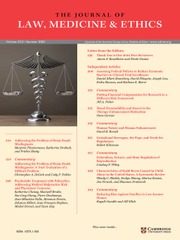No CrossRef data available.
Article contents
What Can We Learn from Patient Input at FDA Advisory Committee Meetings?
Published online by Cambridge University Press: 17 June 2025
Abstract
In their article, Zhang et al. analyze advisory committee decisions on sNDA and sBLA submissions and highlight that committee members can draw on their own or otherwise reported clinical experience with the products, which are already available for other indications when making recommendations. They find that this experience influences members’ judgments of acceptable safety profiles of the products. At advisory committee meetings, patients and their family members may speak during open public hearing sessions. The inclusion of patients, many of whom share their experience with the product, speaks to a tension between asking advisory committee members to make a recommendation based on clinical evidence and the role of experiential testimonies in those recommendations.
Information
- Type
- Commentary
- Information
- Journal of Law, Medicine & Ethics , Volume 53 , Issue 1: Institutional Obligations to Promote Research Integrity , Spring 2025 , pp. 145 - 146
- Copyright
- © The Author(s), 2025. Published by Cambridge University Press on behalf of American Society of Law, Medicine & Ethics
Footnotes
The authors’ work is supported by a Making a Difference Grant from the Greenwall Foundation.

